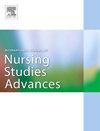评估未满足的通信需求和老年设施工作人员-家属通信质量:仪器开发和心理测量测试
IF 3.1
Q1 NURSING
International Journal of Nursing Studies Advances
Pub Date : 2025-04-19
DOI:10.1016/j.ijnsa.2025.100333
引用次数: 0
摘要
背景:尽管公认有必要改善非交流性照护受助者(即无法与医务人员讨论其在老年机构的治疗和护理的照护受助者)的工作人员与家庭照护者之间的沟通,但没有工具来衡量这种沟通的质量,也没有工具来衡量家庭照护者的沟通需求得到满足的程度。目的开发和测试两种评估工具,以评估家庭照顾者对家庭照顾者沟通需求的满足程度,以及评估家庭照顾者与最常咨询的工作人员的沟通质量。设计仪器开发,包括信度、效度和结构测试。以色列有5个老年医疗设施(2个老年医疗中心和3个养老院)。研究对象为老年医疗机构中128名非交流照护者的家庭照护者。方法在以往研究成果的基础上,我们编制了《家庭照顾者沟通需求问卷》和《工作人员-家庭沟通质量问卷》,分别评估家庭照顾者的沟通需求得到满足的程度和与最常咨询的工作人员的沟通质量。我们通过对参与者的个人访谈来探索工具的项目和信度,并在不同的子样本中检验了家庭照顾者沟通需求问卷的信度和收敛效度。采用因子分析对家庭照顾者沟通需求问卷的结构进行检验。结果两种工具的内部一致性信度均较高(《家庭照顾者沟通需求问卷》,Cronbach′s α = 0.92,共23项;员工-家庭沟通质量问卷,α = 0.86,共8项)。家庭照顾者沟通需求问卷的探索性因素分析强化了先前研究中出现的四个因素(工作人员的可用性和态度、与家庭照顾者的护理经验有关、信息的清晰度和可靠性、语言障碍),共占方差的63.3%。两种工具均表现出良好的收敛有效性。结论《家庭照顾者沟通需求问卷》和《医护人员与家属沟通质量问卷》是评估医护人员与家属沟通质量的有效、可靠的工具,有助于识别沟通的优势和劣势,提出改善沟通的干预措施,并为干预措施提供效果指标。本文章由计算机程序翻译,如有差异,请以英文原文为准。
Assessments of unmet communication needs and quality of staff-family communication at geriatric facilities: Instruments development and psychometric testing
Background
Despite an acknowledged need to improve communication between staff and family caregivers of non-communicative care recipients (i.e., care recipients who are unable to engage in discussions with the medical staff about their treatment and care at geriatric facilities), no tools exist to measure the quality of this communication nor the extent to which family caregivers’ communication needs are met.
Objective
To develop and test two assessment tools to evaluate the extent to which family caregivers' communication needs are met according to family caregivers and for evaluating the quality of communication with the staff member most often consulted.
Design
Instrument development, including reliability, validity, and construct testing.
Settings
Five geriatric facilities (two geriatric medical centers and three nursing homes) in Israel.
Participants
128 family caregivers of non-communicative care recipients at geriatric facilities.
Methods
Based on our previous findings, we developed the Family Caregiver’s Communication Needs Questionnaire, which assesses the extent to which family caregivers' communication needs are met according to them, and the Staff-Family Quality of Communication Questionnaire, which evaluates the quality of communication with the staff member most often consulted. We conducted personal interviews with the participants to explore both tools’ items and reliability and examined the reliability and convergent validity of the Family Caregiver’s Communication Needs Questionnaire in a different sub-sample. The Family Caregiver’s Communication Needs Questionnaire’s construct was tested using a factor analysis.
Results
Both tools’ internal consistency reliabilities were high (Family Caregiver’s Communication Needs Questionnaire, Cronbach’s α = 0.92, 23 items; Staff-Family Quality of Communication Questionnaire, α = 0.86, 8 items). Exploratory factor analysis for the Family Caregiver’s Communication Needs Questionnaire reinforced the four factors that emerged in a prior study (staff's availability and attitude, relating to family caregivers' caregiving experience, clarity and reliability of information, and language barriers), accounting together for 63.3 % of the variance. Both tools demonstrated good convergent validity.
Conclusions
The Family Caregiver’s Communication Needs Questionnaire and Staff-Family Quality of Communication Questionnaire are valid and reliable tools for assessing the quality of staff-family communication, assisting in identifying communication strengths and weaknesses, suggesting potential interventions for improved communication, and providing outcome measures for such interventions.
求助全文
通过发布文献求助,成功后即可免费获取论文全文。
去求助
来源期刊

International Journal of Nursing Studies Advances
Nursing-General Nursing
CiteScore
5.80
自引率
0.00%
发文量
45
审稿时长
81 days
 求助内容:
求助内容: 应助结果提醒方式:
应助结果提醒方式:


